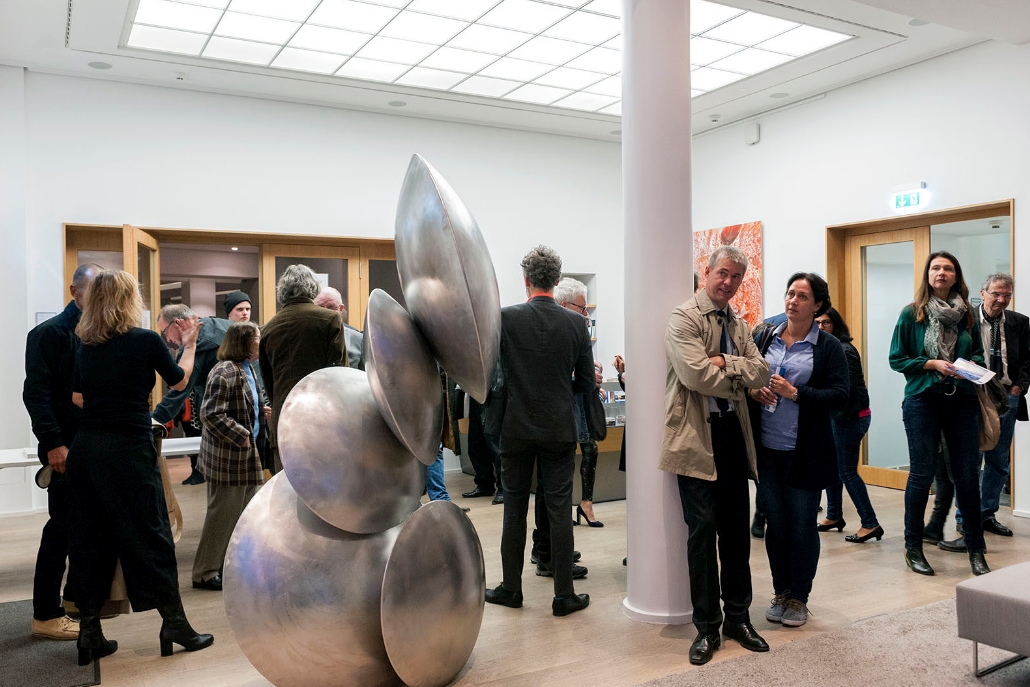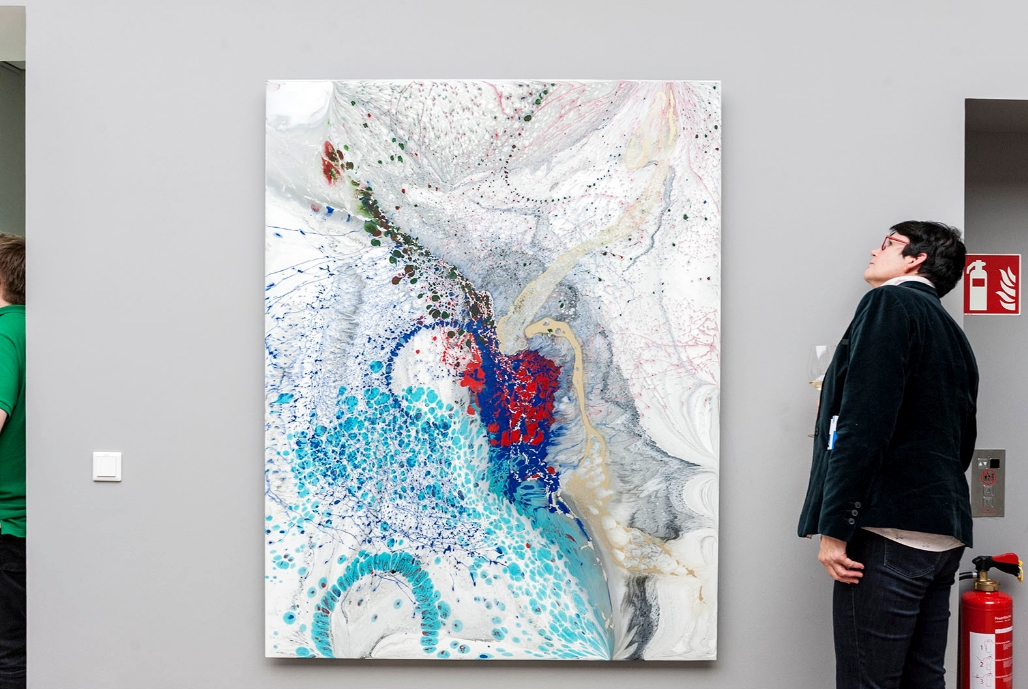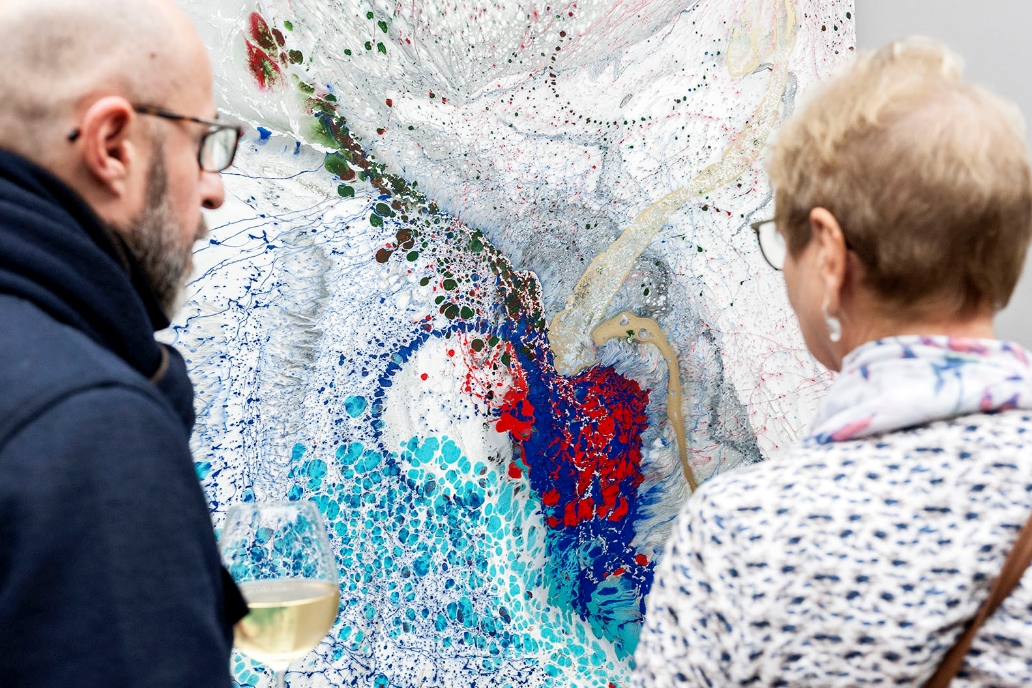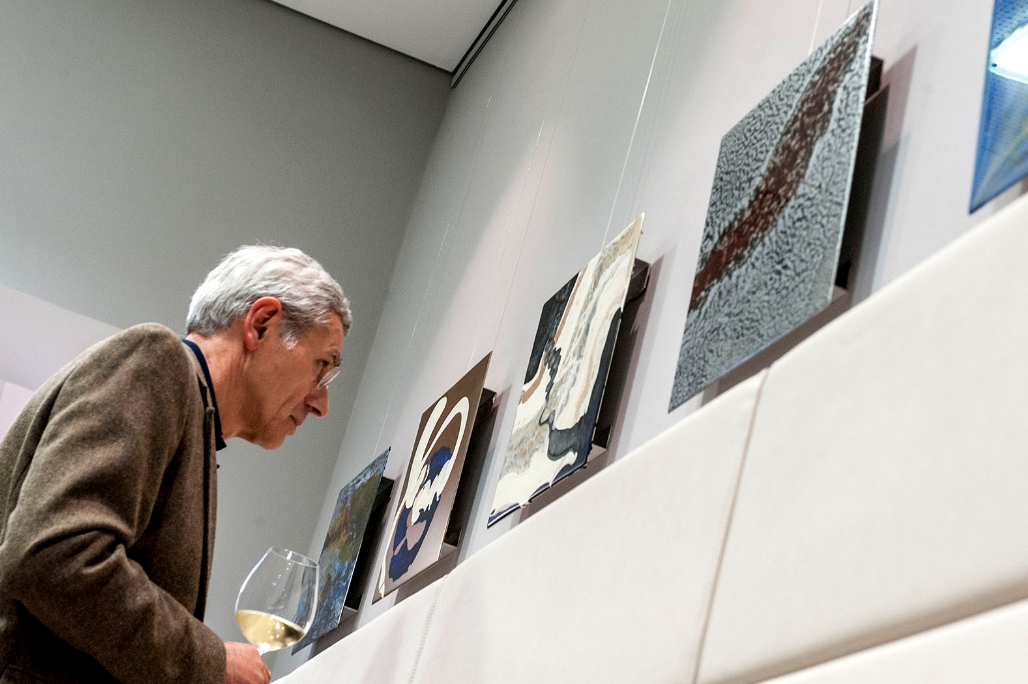Text: Editorial Team | Section: Articles about Artists
Summary: The exhibition ART INSPIRATION SCIENCE Thomas Schönauer—The Engineering Artist took place at Haus der Universität (House of the University) in Düsseldorf. Its main focus was on Schönauer’s collaborative work with scientists, engineers and companies, in which he aims to extract or utilise new materials for artistic practice. Schönauer collaborates with the Henkel corporation as well as with the Institut für Textiltechnik (Institute for Textile Technology) at the RWTH Aachen University.
The exhibition ART INSPIRATION SCIENCE Thomas Schönauer—The Engineering Artist took place from 19 October 2018 to 31 January 2019 at Haus der Universität (House of the University) on Schadowplatz 14 in Düsseldorf.
The following exhibition report includes the original invitation, the exhibition catalogue (the catalogue is available as a PDF here), the welcome speech given by w/k editor Peter Tepe from 19 October 2018 and photos by Karsten Enderlein. At the end you will find links to media reports , which we will keep up-to-date.
Welcome speech by the w/k editor
Dear Ladies and Gentlemen,
After the introduction by Associate Professor Dr Christoph auf der Horst, the Deputy Director of Haus der Universität, I would like to introduce you to the people involved with this project. ART INSPIRATION SCIENCE Thomas Schönauer – The Engineering Artist is the second exhibition on art and science which has been jointly organised by Haus der Universität, represented by Christoph auf der Horst, Jill Praus and Kai Buers; Meral Alma’s Kunstakademie.gallery; and the online journal w/k—Between Science and Art, founded and published by me. Of course, Thomas Schönauer himself also played a decisive role. To begin with, I would like to thank the whole exhibition team for the great cooperation.

Last year’s exhibition, which some of you will remember, had the title Art and Science: Examples of symbiotic relations. It presented ten artists and scientists who share a close connection to the Art Academy Düsseldorf, to the Heinrich Heine University and to the city of Düsseldorf itself. The focus was on the scientist and artist Karl Otto Götz, who died recently at the age of 103. He worked as an empirical psychologist in the 1960s and 1970s with the support of his wife, Rissa. Together with leading psychologists of his time such as Hans Jürgen Eysenck and Daniel Berlyne, he developed test procedures to determine aesthetic competence.
In contrast to last year, this year’s exhibition focuses on only one artist, thus taking on a different format. The foyer meets the expectations typical of an art exhibition: it exhibits one of Schönauer’s sculptures which is characteristic of his works from recent years as well as two pictures produced using a novel method; the artist prefers to call them Paintings. Somewhat unusual are perhaps the short films presented on a screen showing, for instance, the process of making such a picture.
Certain elements on the first and second floor begin to break up the typical context of an art exhibition. Schönauer is one of the few artists who actively engage with scientists, engineers, companies, and collaborates with them for specific purposes. The two exhibition floors focus on Schönauer’s collaborations: the first on his work with the Düsseldorf company Henkel and the second on his cooperation with the Institute for Textile Technology led by Thomas Gries at the RWTH Aachen University. Several examples demonstrate the form these collaborations take and the artistic results they have yielded.
Before I commence defining Schönauer’s specific position between the poles of art and science in further detail, I will share some information on the person so closely connected to the city of Düsseldorf. Born in 1953, he studied German and Romance literature and philosophy at the Heinrich Heine University for some time, before working for the sculptor Friedrich Werthmann. He subsequently studied some more semesters at the art academies in Winnipeg (Canada) and Düsseldorf. Establishing himself as a visual artist was a gradual process. “The non-material world is not my world. As someone who is tactile by nature, I can’t find satisfaction in a purely intellectual pursuit in the long run.” I shall continue to intersperse Schönauer quotes to achieve a deeper understanding of him as an artist.
Schönauer describes himself as a “man of spaces”. His perhaps unusual collaborations for a visual artist, working closely with architects and landscape planners, have led him to win several international tenders. Here are two examples: in 1992 he developed the overall concept for Germany’s appearance at the UN Earth Summit, and between 1990 and 1992 he created the concept and sculptural installations for the Aquarius Water Museum in Mülheim an der Ruhr. A quote by Schönauer may serve as an illustration of these activities: “First one must feel the vibrations, the atmosphere of a space or a place before devising a plan”.
Since architects rely on collaborations with engineers and companies to carry out their building projects, it made great sense for Schönauer to adopt this way of working as a visual artist. Frank Dopheide, the managing director of the Handelsblatt publishing group, thus aptly described him as an Engineering Artist.
Where, then, is Schönauer to be placed between the poles of art and science? In the online journal w/k we split the various science-art connections into three main categories, allowing room for variation depending on each individual case. The first category includes those working as scientists as well as artists; in w/k we refer to these as border crossers between the two areas. Karl Otto Götz is a primary example. The second category includes artists who rely upon scientific theories/methods/results as science-related artists. The third category includes artists working together with scientists (as well as engineers): the collaboration between at least one artist and at least one scientist.
I will now take a closer look at the science-art connections specific to Schönauer. For a sculpture series which is not exhibited here, he studied the world’s atomic structure, gained scientific knowledge about it and used this knowledge as a starting point for an artistic process also showing elements of humour and persiflage. In Schönauer’s words: “My main concern was whether one can approach the earth’s atomic structure through sculpture.”
In other series of works Schönauer also proves to be a science-related artist. This includes his interest in themes such as micro- and macrocosm and chaos and order which goes back to his brief studies in philosophy and can be seen in his Paintings, some of which are part of this exhibition.
Is Schönauer also a border crosser between science and art? Unlike Götz, for instance, he does not carry out scientific research over a long period of time whose results are then published in specialist journals or in book form. “I am not a scientist,” he says, “that would be presumptuous.” He is, however, working together with the photographer Ralph Richter and others on a critically aligned theory of linear thinking that also addresses current societal challenges such as populism and digitalisation. Schönauer distinguishes between linear thinking, which aims to maintain the status quo and depends on hierarchies, and dispersed, networked thinking, which favours innovation. Linear thinking is to be understood as dogmatic thinking, which only follows one path and disregards anything that does not fit or has changed due to external factors. On this topic he publishes smaller texts and, at congresses and similar occasions, holds lectures on it. In short, Schönauer does not work as a scientist in the strict sense, but he has independently developed a theory of a critical nature. He can therefore, to a certain extent, be considered a border crosser.
Ultimately, Schönauer is an artist who collaborates with scientists, engineers and companies—and the exhibition focuses on this side of his work. I will first discuss his collaboration with Henkel. Together with material researchers and chemists specialising in adhesives, Schönauer experimented with the industrial bonding of steel, which inspired him to use stainless steel as a painting ground. “The surface is no longer absorbent—liquids can spread easily.” He recalls a spontaneous studio visit from Ms Bagel-Trah who leads Henkel’s supervisory board; she was fascinated by Schönauer’s experiments and asked about the procedure. “Her enthusiasm,” Schönauer explains, “opened up doors to world-market leading laboratories for adhesives, which of course creates incredible opportunities for a visual artist interested in such research.” Schönauer’s Paintings demonstrate the artistic application of industrial adhesives. He thus realises his artistic goal—to create the third dimension on a surface—in a novel way. “Adhesives are always between something. I now attempt to give the adhesive a life of its own and to aestheticise it.” This leads to a very specific collaboration between art and industry, a special variation of the engineering artist. The first floor presents the intense collaborative work: Studio photos, first artistic results and much more.
Now to the second collaboration that I would like to introduce: Schönauer’s cooperation with the Institute for Textile Technology (ITA) at the RWTH Aachen University. The institute is led by Professor Thomas Gries, whereby Dr Andreas Koch also plays a leading role. ITA developed an innovative composite textile-reinforced concrete, primarily used for thin-walled and light precast concrete elements (e.g. facade elements) and for sustainable renovation of existing concrete structures, such as bridges. From the very beginning, Schönauer’s collaborators at RWTH were convinced that textile-reinforced concrete, due to its particularly lightweight, delicate and malleable characteristics, could be used to realise artistic works.
So how did the actual implementation of this idea come about? The collaboration with the RWTH arose from Schönauer’s visit to the Institute for Textile Technology; he was impressed by the possibilities that textile-concrete had to offer. The two parties promptly envisioned a collaboration from which both sides could benefit. Subsequently, Schönauer developed the sculpture project CON-TEXTURES, and, on the basis of this, the trophy for the Aachen 2025 competition rewarding ideas and projects exploring the age of digital challenges as a phenomenon which can take on different forms. As Schönauer says: “This very special material creates an airy, sail-like, almost weightless connotation.” The large sculpture will be presented to the public next month, in November 2018. On the second floor you will find a model and many documents on the collaboration between ITA and the artist.
In summary, Thomas Schönauer encompasses all three main categories of science/art connections interesting for w/k. Further research would be needed to find more such artists. I’m sure there won’t be many.
Both art and science exhibitions at Haus der Universität offered visitors a great deal of additional information to enable a deeper understanding of the works of art, which is of central importance for the exhibition concept. In our first exhibition we used information panels and roll-ups. For the new exhibition we switched to the more flexible wall and door labels.
I now come back to the Schönauer quotes I used in my welcome speech, originally published in two w/k interviews with artists—with the exception of one. They clarify Schönauer’s artistic goals and theoretical thinking, as well as the main motivations behind his critically aligned theory of linear thinking, helping us to better understand the main interests at play in his artistic practice. One of the films presented at the exhibition gives further insight into Schönauer’s artistic approach. It shows the creation process of his Paintings, which slightly alters the way we perceive the finished pictures.
As most of you will have read on the invitation, a panel discussion led by the journalist Regine Müller will take place at Haus der Universität on 29 November to accompany the exhibition. It would be an absolute pleasure to see many of you there again.
I wish you all a fruitful visit to the exhibition and many enjoyable conversations with those involved. Thank you for listening.
________________________________________________________________________
All Schönauer quotes are from the two interviews with artists which were published in w/k, with the exception of one which was taken from a newspaper article. For the purpose of this lecture I slightly modified the language and length of the quotes, without specifying these in detail.
Photos of the opening by Karsten Enderlein
▷ More photos by Karsten Enderlein
Header image above text: Opening ART INSPIRATION SCIENCE (2018). Photo: Karsten Enderlein.
Translated by Rebecca Grundmann.
How to cite this article
Editorial Team (2020): ART INSPIRATION SCIENCE. w/k–Between Science & Art Journal. https://doi.org/10.55597/e6286








Be First to Comment